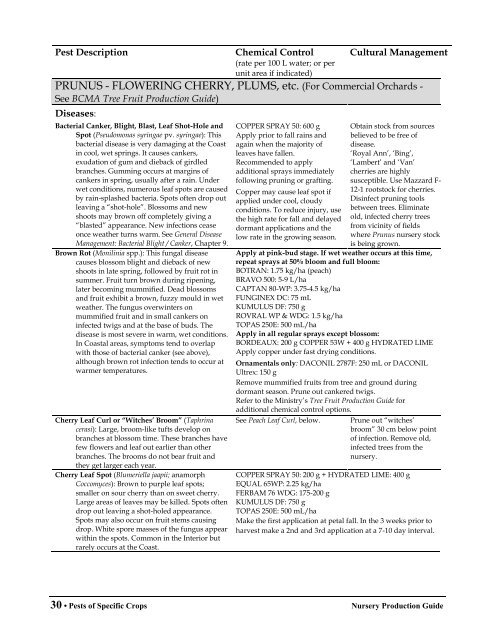You also want an ePaper? Increase the reach of your titles
YUMPU automatically turns print PDFs into web optimized ePapers that Google loves.
Pest Description<br />
Chemical Control<br />
(rate per 100 L water; or per<br />
unit area if indicated)<br />
Cultural Management<br />
PRUNUS - FLOWERING CHERRY, PLUMS, etc. (For Commercial Orchards -<br />
See BCMA Tree Fruit Production Guide)<br />
Diseases:<br />
Bacterial Canker, Blight, Blast, Leaf Shot-Hole and<br />
Spot (Pseudomonas syringae pv. syringae): This<br />
bacterial disease is very damaging at the Coast<br />
in cool, wet springs. It causes cankers,<br />
exudation <strong>of</strong> gum and dieback <strong>of</strong> girdled<br />
branches. Gumming occurs at margins <strong>of</strong><br />
cankers in spring, usually after a rain. Under<br />
wet conditions, numerous leaf spots are caused<br />
by rain-splashed bacteria. Spots <strong>of</strong>ten drop out<br />
leaving a “shot-hole”. Blossoms and new<br />
shoots may brown <strong>of</strong>f completely giving a<br />
“blasted” appearance. New infections cease<br />
once weather turns warm. See General Disease<br />
Management: Bacterial Blight / Canker, Chapter 9.<br />
Brown Rot (Monilinia spp.): This fungal disease<br />
causes blossom blight and dieback <strong>of</strong> new<br />
shoots in late spring, followed by fruit rot in<br />
summer. Fruit turn brown during ripening,<br />
later becoming mummified. Dead blossoms<br />
and fruit exhibit a brown, fuzzy mould in wet<br />
weather. The fungus overwinters on<br />
mummified fruit and in small cankers on<br />
infected twigs and at the base <strong>of</strong> buds. The<br />
disease is most severe in warm, wet conditions.<br />
In Coastal areas, symptoms tend to overlap<br />
with those <strong>of</strong> bacterial canker (see above),<br />
although brown rot infection tends to occur at<br />
warmer temperatures.<br />
Cherry Leaf Curl or “Witches’ Broom” (Taphrina<br />
cerasi): Large, broom-like tufts develop on<br />
branches at blossom time. These branches have<br />
few flowers and leaf out earlier than other<br />
branches. The brooms do not bear fruit and<br />
they get larger each year.<br />
Cherry Leaf Spot (Blumeriella jaapii; anamorph<br />
Coccomyces): Brown to purple leaf spots;<br />
smaller on sour cherry than on sweet cherry.<br />
Large areas <strong>of</strong> leaves may be killed. Spots <strong>of</strong>ten<br />
drop out leaving a shot-holed appearance.<br />
Spots may also occur on fruit stems causing<br />
drop. White spore masses <strong>of</strong> the fungus appear<br />
within the spots. Common in the Interior but<br />
rarely occurs at the Coast.<br />
COPPER SPRAY 50: 600 g<br />
Apply prior to fall rains and<br />
again when the majority <strong>of</strong><br />
leaves have fallen.<br />
Recommended to apply<br />
additional sprays immediately<br />
following pruning or grafting.<br />
Copper may cause leaf spot if<br />
applied under cool, cloudy<br />
conditions. To reduce injury, use<br />
the high rate for fall and delayed<br />
dormant applications and the<br />
low rate in the growing season.<br />
Obtain stock from sources<br />
believed to be free <strong>of</strong><br />
disease.<br />
‘Royal Ann’, ‘Bing’,<br />
‘Lambert’ and ‘Van’<br />
cherries are highly<br />
susceptible. Use Mazzard F-<br />
12-1 rootstock for cherries.<br />
Disinfect pruning tools<br />
between trees. Eliminate<br />
old, infected cherry trees<br />
from vicinity <strong>of</strong> fields<br />
where Prunus nursery stock<br />
is being grown.<br />
Apply at pink-bud stage. If wet weather occurs at this time,<br />
repeat sprays at 50% bloom and full bloom:<br />
BOTRAN: 1.75 kg/ha (peach)<br />
BRAVO 500: 5-9 L/ha<br />
CAPTAN 80-WP: 3.75-4.5 kg/ha<br />
FUNGINEX DC: 75 mL<br />
KUMULUS DF: 750 g<br />
ROVRAL WP & WDG: 1.5 kg/ha<br />
TOPAS 250E: 500 mL/ha<br />
Apply in all regular sprays except blossom:<br />
BORDEAUX: 200 g COPPER 53W + 400 g HYDRATED LIME<br />
Apply copper under fast drying conditions.<br />
Ornamentals only: DACONIL 2787F: 250 mL or DACONIL<br />
Ultrex: 150 g<br />
Remove mummified fruits from tree and ground during<br />
dormant season. Prune out cankered twigs.<br />
Refer to the Ministry’s Tree Fruit Production Guide for<br />
additional chemical control options.<br />
See Peach Leaf Curl, below.<br />
Prune out “witches’<br />
broom” 30 cm below point<br />
<strong>of</strong> infection. Remove old,<br />
infected trees from the<br />
nursery.<br />
COPPER SPRAY 50: 200 g + HYDRATED LIME: 400 g<br />
EQUAL 65WP: 2.25 kg/ha<br />
FERBAM 76 WDG: 175-200 g<br />
KUMULUS DF: 750 g<br />
TOPAS 250E: 500 mL/ha<br />
Make the first application at petal fall. In the 3 weeks prior to<br />
harvest make a 2nd and 3rd application at a 7-10 day interval.<br />
30 • <strong>Pests</strong> <strong>of</strong> <strong>Specific</strong> <strong>Crops</strong> Nursery Production Guide
















